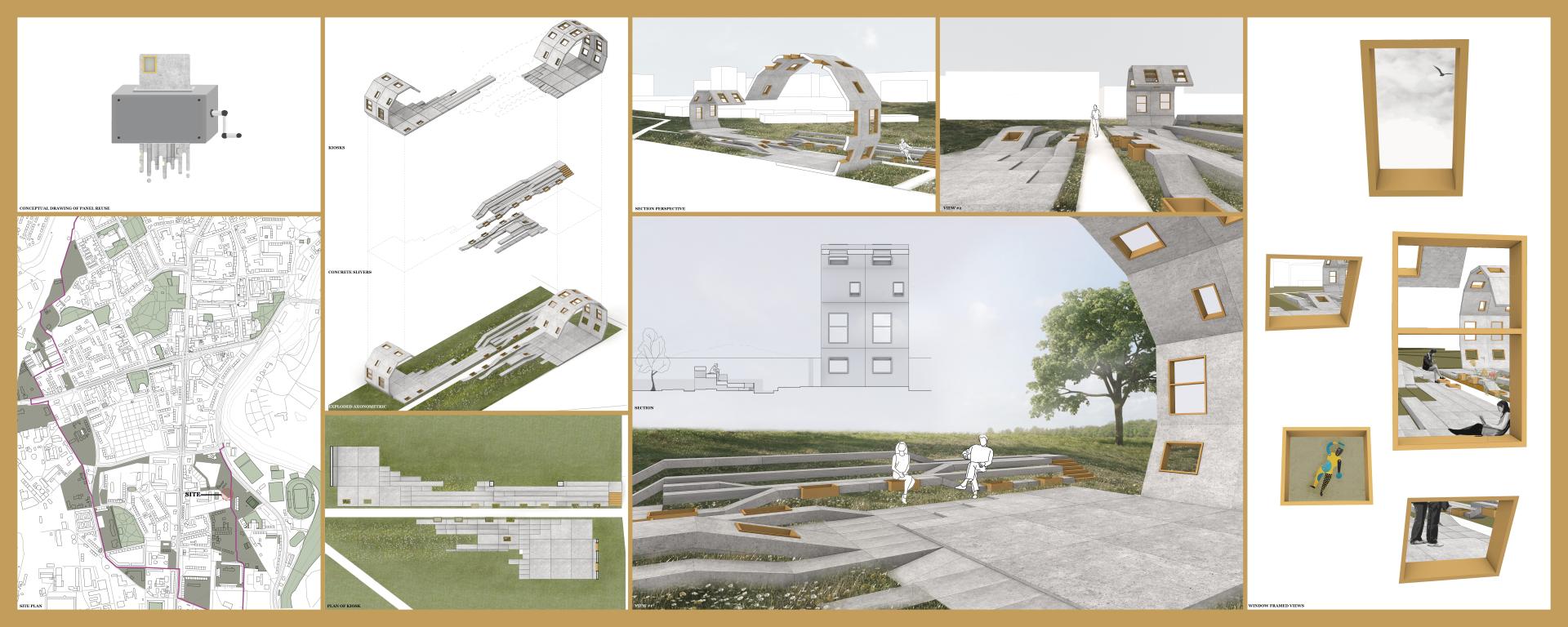Design for an architectural rug (2022)
Basic information
Project Title
Full project title
Category
Project Description
My proposal is a kiosk made out of reused plattenbau panels whose form is inspired by the weaving process of Annie Albers. The design aims to interlace the natural landscape with the built environment until they are both speaking the same language in an almost rhythmic composition mimicking the weaving process that unifies separate components. The project aims to improve our relationship with nature by bringing the community of Dessau, Germany closer to their natural surroundings.
Geographical Scope
Project Region
Urban or rural issues
Physical or other transformations
EU Programme or fund
Which funds
Description of the project
Summary
Biophilia, a concept coined by Edwards O. Wilson, describes humans' inherent need and attraction to nature. Nature is an indispensable ingredient to the human environment, and we can see this need being evoked through various components that make up our social structure and the organization of our societies. Human divergence from nature happened as technologies evolved and allowed us to build enclosed, sterile spaces, along with cars that sheltered us from the wilderness.
Therefore, the question is: how do we enhance our relationship to nature?
Well, we design with it instead of against it.
The New Bauhaus Competition project started by looking at Annie Albers, an influential textile artist from the Bauhaus, who redefined the field of weaving by thinking of the structural and spatial defining capabilities of thread when creating her weaves. Hence, her work encouraged me to imagine the possibilities of weaving beyond the pictorial and textile dimensions. My proposal is a kiosk that utilizes reused concrete (plattenbau panels) and uses the material in a way that mimics the grace and elegance in which a weaver interlaces the weft threads between the warp threads creating a systematic and almost rhythmic composition that unifies separate components.
In the case of the project, I took inspiration from the weaving process to interlace the natural landscape with the built environment until they were both speaking the same language. The project aims to create and improve our relationship with nature by bringing the community of Dessau, Germany, closer to their natural surroundings, hopefully changing their perspective towards nature and fostering environmental education to gain support for conservation efforts.
The concrete reuse concept follows the action of shredding fabric to create concrete slivers that can conform to the surrounding conditions on the red thread when placed in different configurations.
Key objectives for sustainability
The key objectives of my project were:
1) to design a structure using reused materials, in this case, using plattembau panels from demolished buildings in Dessau, Germany. Hence, contributing to a circular economy by preventing these materials from going into landfills.
2) connecting people with nature, in this case, the kiosk and the surrounding landscape, follows the same weaving and shredding logic, making it easier for people disinterested in nature to discern natural processes and phenomena just by paying attention to the hardscape.
3) Facilitate social inclusion; in this case, The concrete slivers that make up the logic of the kiosk can conform to the surrounding conditions along the red thread when placed in different configurations, thus facilitating access to other areas in Dessau and promoting social inclusion.
Key objectives for aesthetics and quality
The key objective of my project under this dimension was to create a fun and engaging space that would appeal to people of all ages so that everyone could enjoy the benefits that nature has to offer in terms of health and wellbeing and the benefits that come from taking care of our natural resources. In the case of my project, it is striking to see a structure that tries to blend in with nature and reuses plattenbau panels in such an honest and unapologetic way.
Key objectives for inclusion
The key objective of my project in terms of inclusion is:
1) to create equal opportunities for engagement with nature, in the case of the project, having various interventions along the red thread should serve different areas with varying demographics who will add their meaning and programmatic purpose to their closest intervention.
2) to create a low-cost structure, in the case of this project, the original plattenbau panels should be reused or resized into narrower panels without any additional intervention. Not needing additional beautification methods will lower construction costs and contribute to sustainability.
Results in relation to category
My project will hopefully impact the way people feel about nature and spark intellectual curiosity in learning more about our natural world.
How Citizens benefit
My intervention did not involve physical transformations where the public was involved in the construction or design of the kiosk. However, I envision the community helping put together the concrete slivers in various configurations depending on their specific needs and wants. Thus, giving their unique meaning to the structure.
Physical or other transformations
Innovative character
The project's innovative character lies in its honest use of material and architecture's ability to serve as a platform that tackles larger contemporary issues such as climate change while giving more than it takes from its community and surroundings.
Learning transferred to other parties
The project could be translated to other contexts; however, using local materials such as plattenbau panels only makes sense in Germany, where these buildings are located. If the project was to change contexts, local materials would have to be used so that the embodied carbon remains the same. Although, changing materials would undoubtedly change the character of the project.

